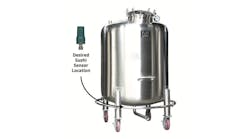In recent years the Separations Research Program (SRP) at the University of Texas at Austin has been involved in testing pilot plant processes that require significant equipment modifications and additions. In these activities, process setup and decommissioning take about three times longer than the actual runs. So, decreasing setup time and pilot plant downtime are a high priority. Use of wireless transmitters provides a new degree of flexibility in reconfiguring the process without installing or relocating transmitter wiring.
The flexibility of being able to work on the absorber and stripper without disconnecting cables offers ongoing benefit by reducing downtime and maintenance. However, many measurements that are candidates for switching to wireless transmitters serve for control. Thus, measurement reliability and control performance achievable using wireless transmitters were of primary concern. To allow direct comparison of the performance of wireless versus wired installations, wireless transmitters were installed in parallel with wired transmitters for a few critical loops on an absorber and stripper process. This article presents the results of these tests.
PROCESS EQUIPMENT
The equipment setup used to evaluate application of wireless transmitters in control currently serves for testing new energy-efficient stripping processes associated with carbon dioxide capture from coal-fired power plants. From a process standpoint, this involves an absorber to remove CO2 from a simulated stack-gas stream using an amine-based solvent and then a stripper to recover the CO2 and recycle the regenerated amine solution to the absorber. The photo shows the equipment.
The absorber generally tests proprietary solvents and packing or tray internals. The absorption column provides two 10-ft beds of packing. A liquid collector and liquid re-distributor are located in the middle of the column. In the SRP CO2-capture experiments, ambient air is blended with recycled stripped CO2 and make-up CO2 and fed to the bottom of the column. Carbon dioxide is absorbed into the downflowing amine solvent as the gas flows up through the packing. The exiting solvent, referred to as the rich amine, goes to the stripping section to remove the absorbed CO2.
[sidebar id="1"]The stripper tests packings and determines the energy efficiency associated with a proprietary solvent. This column also has two 10-ft beds of packing. A liquid collector and liquid re-distributor are located in the middle of the column. The solvent leaving the absorber, referred to as the rich amine, is heated with the stripper bottoms liquid using a cross-plate exchanger and then is fed to the top of the stripper. A kettle-type reboiler generates vapor to strip off some of the carbon dioxide. The overhead from the stripper goes to a shell-and-tube condenser where the vapor is condensed and lean amine is returned to the absorber feed tank.
WIRELESS INSTALLATION
Over the last few years development and design of wireless field devices for the process industries has rapidly advanced. After a review of available wireless technology, WirelessHART devices were selected for installation at the SRP. (For details about the technology, see "Make the Most of WirelessHART.") Pressure and differential pressure transmitters were put in to support testing of control of column pressure and steam flow.
The WirelessHART gateway was centrally located in the process area and connected to the control system via Ethernet. A DeltaV control system installed in the SRP provides standard support for the WirelessHART gateway as well as configuration, setup and diagnostics of WirelessHART devices. Thus, the effort to integrate these devices into the control system software configuration matched that associated with traditional field devices. Because these devices are battery powered, no power wiring was required to install them in the process.
The existing control modules for column pressure and steam flow control were modified to allow the operator to switch between wireless and wired inputs. When control with wireless input was selected, the PID modifications for wireless control were automatically used. Also, the new measurements and a switch to select the source of control input were added to the operator displays. Thus, using their normal displays the operators can visually compare wired and wireless measurements at all times and select the measurement to be used in control.
Metrics were added to the control module to calculate the integral of absolute error (IAE) while on automatic control. Also, the number of new measurement values used in control and the duration of control were automatically captured to allow comparison of wired versus wireless control performance.
THE TRIALS
Preliminary tests of a wireless pressure transmitter and a steam-flow differential pressure transmitter took place during a recent packing characterization test to determine distillation efficiency and hydraulic performance of Raschig-Jaeger RSP-250 structured packing. (The stripper also may be used as a distillation column.) The column was operated at total reflux using the cyclohexane/n-heptane binary system. The effect of pressure on distillation performance also was studied. The standard test pressures were 2.4, 4.83, 24 and 60 psia. In the wireless testing, the base pressure was 24 psia. The project sponsor, Raschig-Jaeger, had agreed to allow the wireless testing during the runs.
Figure 1 shows pressure control achieved on the column with a wired pressure transmitter and a wireless one. For these tests, the proportional-integral-derivative (PID) tuning, filtering and control configuration were exactly the same. As this demonstrates, there are no visible differences in performance.
Similar results were observed using wired versus wireless transmitters for steam flow control. Filtering was 10 sec. for the wired measurement and zero for the WirelessHART one; the original plant PID tuning was used for both wired and wireless control. The same dynamic control was seen for set-point changes.
As the table details, comparable control performance versus wired, as measured by IAE, was achieved for both pressure control and steam flow control using WirelessHART measurements with the PID modified for wireless communication. However, WirelessHART used one-tenth the number of measurement samples for flow control and one-sixth the number for pressure control as wired control to reduce battery drain.
These test results indicate the combination of WirelessHART transmitters with PID modifications for wireless communication performed as reliably as the standard SRP hard-wired transmitters using traditional PID. Additional tests were carried out where compositional and packing efficiency HETP (height equivalent to a theoretical plate) data were obtained using the SRP hard-wired transmitters and then the operation was transitioned to the wireless transmitters and control. No differences in the relative bottoms and distillate compositions or HETP were observed in the wireless mode.
A POSITIVE STEP
Installation of WirelessHART transmitters for stripper steam flow and column pressure has eliminated the cost to relocate wiring. Column- pressure and heater steam-flow control using WirelessHART transmitters and PID modified for wireless communication provide the same dynamic response and performance as that achieved using wired transmitters and traditional PID.
The application of WirelessHART is being extended to other areas at SRP. For example, three wireless temperature transmitters (4 RTD inputs per device) are being put in to monitor temperature distribution across the absorber. Also, two wireless pH transmitters are being installed in the lean liquid input and rich liquid outlet streams of the absorber to indirectly monitor CO2 concentration in the amine solution. Using wireless transmitters should improve the accuracy and reliability of the temperature and pH measurements — and hence enhance stripper and absorber operation — because the battery-powered transmitters aren't as susceptible to the ground loops that often plague a wired installation.
FRANK SEIBERT, P.E. is technical manager of the Separations Research Program at the University of Texas at Austin. TERRY BLEVINS is a principal technologist for Emerson Process Management, Austin, Texas. E-mail them at [email protected] and [email protected].
REFERENCES
1. Broadley, S., Karschnia, R., Nixon, M. and Blevins, T., "Using Wireless Transmitters in Single-Use Disposable Bioreactor Control," IFPAC Conf., Baltimore, Md. (Jan. 2009).
2. Nixon, M., Chen, D., Blevins, T. and Mok, A., "Meeting Control Performance over a Wireless Mesh Network," 4th Annual IEEE Conf. on Automation Science and Engineering (CASE 2008), Washington D.C. (Aug. 2008).
3. Johnston, G. and Munns, A., "Make the Most of WirelessHART," Chemical Processing, May 2008, www.ChemicalProcessing.com/articles/2008/071.html.
4. Chen, D., Nixon, M., Blevins, T., Wojsznis, W., Song, J. and Mok A., "Improving PID Control under Wireless Environments," ISA Expo Houston (Oct. 2006).

